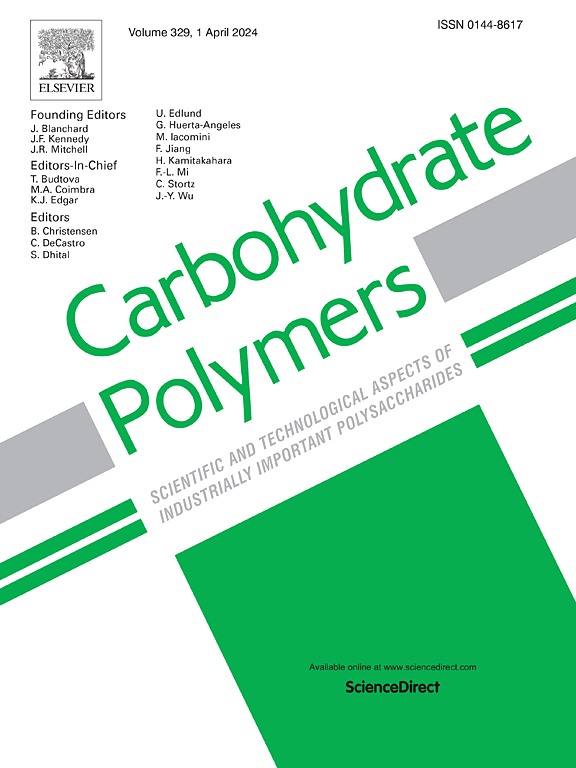In vitro fecal fermentation characteristics of starch-chitosan composite prepared by screw extrusion
IF 10.7
1区 化学
Q1 CHEMISTRY, APPLIED
引用次数: 0
Abstract
In this study, we prepared a series of composites with various chitosan-to-starch ratios by means of screw extrusion. The morphology and structural order of the composite were examined, and the fermentability was investigated through an in vitro human fecal fermentation model. Fourier transform infrared (FTIR) spectroscopy demonstrated the formation of hydrogen bonds between starch and chitosan in the composite, and X-ray diffraction (XRD) analysis indicated the structural order of the composite was enhanced with increasing chitosan proportions. The addition of chitosan slowed down the pH drop rate during the fermentation, and high chitosan proportion decreased the production of short-chain fatty acids (SCFAs), especially butyrate. The final butyrate concentrations of the composite with chitosan to starch ratio of 1:6 (CS:S = 1:6, 0.97 mmol/g) was almost twice that of the composite with chitosan to starch ratio of 2:1 (CS:S = 2:1, 0.51 mmol/g). Health-promoting microbes including Agathobacter, Prevotella_9, Ruminococcus, and Bifidobacterium were obviously promoted by extruded starch. Moreover, the composite sample with chitosan to starch ratio of 1:6 (CS:S = 1:6) exhibited a good synergistic effect in regulating the microbiota composition, reflected by the increase in the relative abundance of Agathobacter and Prevotella_9. This finding demonstrated that the ratio of starch to chitosan might be a controlling factor in determining the fermentation properties of screw extruded composite.

螺旋挤压法制备淀粉-壳聚糖复合材料体外发酵特性研究
在本研究中,我们采用螺杆挤出法制备了一系列具有不同壳聚糖与淀粉比例的复合材料。研究了复合材料的形态和结构顺序,并通过体外人粪便发酵模型研究了其可发酵性。傅里叶变换红外光谱(FTIR)证实淀粉和壳聚糖在复合材料中形成了氢键,x射线衍射(XRD)分析表明,随着壳聚糖比例的增加,复合材料的结构有序性增强。壳聚糖的添加减缓了发酵过程中pH下降的速度,高比例的壳聚糖降低了短链脂肪酸(SCFAs)的产量,尤其是丁酸酯的产量。壳聚糖与淀粉比例为1:6 (CS:S = 1:6, 0.97 mmol/g)的复合材料的最终丁酸盐浓度几乎是壳聚糖与淀粉比例为2:1 (CS:S = 2:1, 0.51 mmol/g)的两倍。膨化淀粉对无水杆菌、普雷沃氏菌、瘤胃球菌和双歧杆菌等有益健康的微生物有明显的促进作用。此外,壳聚糖与淀粉比例为1:6 (CS:S = 1:6)的复合样品在调节微生物群组成方面表现出良好的协同作用,表现为Agathobacter和Prevotella_9的相对丰度增加。这表明淀粉与壳聚糖的比例可能是决定螺杆挤压复合材料发酵性能的一个控制因素。
本文章由计算机程序翻译,如有差异,请以英文原文为准。
求助全文
约1分钟内获得全文
求助全文
来源期刊

Carbohydrate Polymers
化学-高分子科学
CiteScore
22.40
自引率
8.00%
发文量
1286
审稿时长
47 days
期刊介绍:
Carbohydrate Polymers stands as a prominent journal in the glycoscience field, dedicated to exploring and harnessing the potential of polysaccharides with applications spanning bioenergy, bioplastics, biomaterials, biorefining, chemistry, drug delivery, food, health, nanotechnology, packaging, paper, pharmaceuticals, medicine, oil recovery, textiles, tissue engineering, wood, and various aspects of glycoscience.
The journal emphasizes the central role of well-characterized carbohydrate polymers, highlighting their significance as the primary focus rather than a peripheral topic. Each paper must prominently feature at least one named carbohydrate polymer, evident in both citation and title, with a commitment to innovative research that advances scientific knowledge.
 求助内容:
求助内容: 应助结果提醒方式:
应助结果提醒方式:


